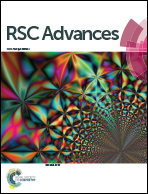Mesoporous Co3O4@carbon composites derived from microporous cobalt-based porous coordination polymers for enhanced electrochemical properties in supercapacitors†
Abstract
In this work, mesoporous Co3O4@carbon composites were prepared through a simple, one-step, carbonization of microporous cobalt-based porous coordination polymer ZSA-1. After the carbonization, the original octahedral shape of the precursor ZSA-1 has been well preserved, and the obtained octahedrons consisted of irregular nanoparticles with an average size of 10 nm. The as-synthesized Co3O4@carbon composites displayed mesoporous apertures with an average pore size of 3.6 nm. The octahedral Co3O4@carbon composites were evaluated as an electrode material of supercapacitors by cyclic voltammetry (CV) and galvanostatic charge/discharge tests. The electrochemical results show that the mesoporous Co3O4@carbon composites exhibit a specific capacitance of 205.4 F g−1 at a current density of 0.2 A g−1. Furthermore, the characterization of mesoporous Co3O4@carbon composites was fully developed, including powder X-ray diffraction, scanning electron microscopy, transmission electron microscopy, N2 adsorption, thermal gravimetric analyses, and Raman spectroscopy.


 Please wait while we load your content...
Please wait while we load your content...